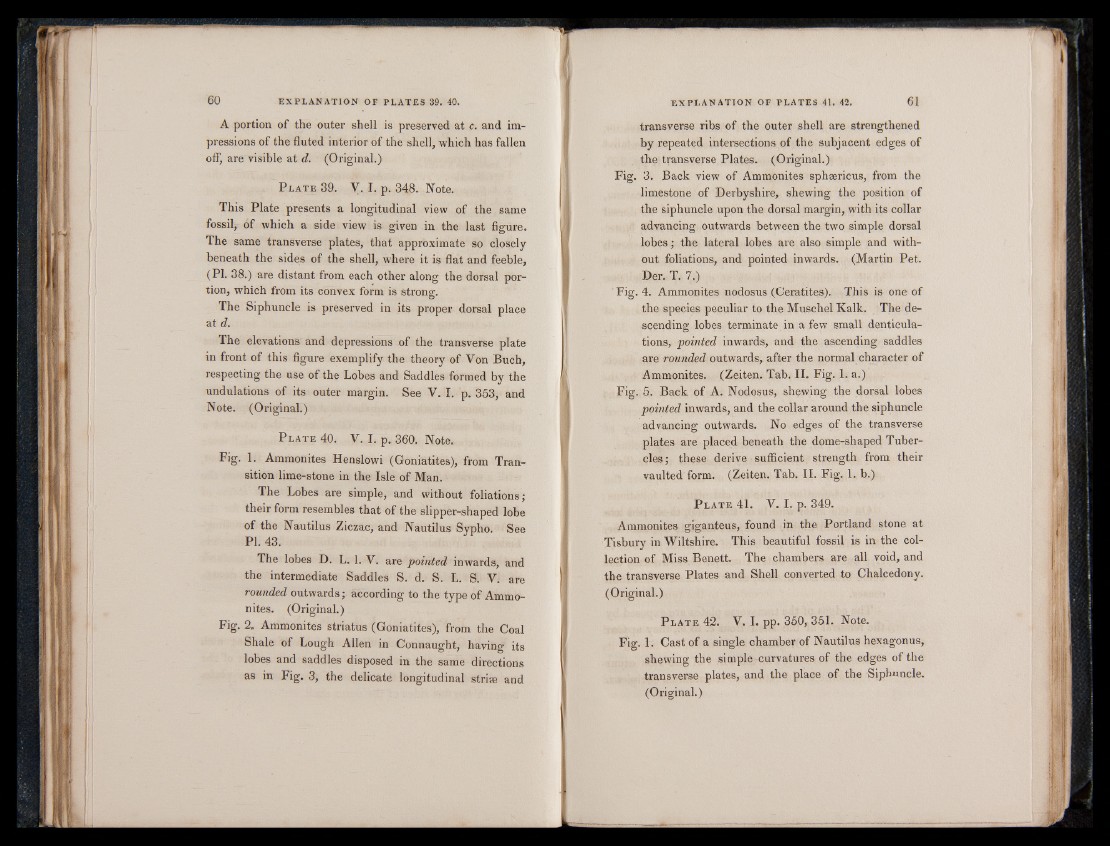
A portion of the outer shell is preserved at c. and impressions
of the fluted interior of the shell, which has fallen
off, are visible at d. (Original.)
P late 39. V. I. p. 348. Note.
This Plate presents a longitudinal view of the same
fossil, of which a side view is given in the last figure.
The same transverse plates, that approximate so closely
beneath the sides of the shell, where it is flat and feeble,
(PI. 38.) are distant from each other along the dorsal portion,
which from its convex form is strong.
The Siphuncle is preserved in its proper dorsal place
at d.
The elevations and depressions of the transverse plate
in front of this figure exemplify the theory of Von Buch,
respecting the use of the Lobes and Saddles formed by the
undulations of its outer margin. See V. I. p. 353, and
Note. (Original.)
P late 40. V. I. p. 360. Note.
Fig. 1. Ammonites Henslowi (Goniatites), from Transition
lime-stone in the Isle of Man.
The Lobes are simple, and without foliations;
their form resembles that of the slipper-shaped lobe
of the Nautilus Ziczac, and Nautilus Sypho. See
PI. 43.
The lobes D. L. 1. V. are pointed inwards, and
the intermediate Saddles S. d. S. L. S. V. are
rounded outwards; according to the type of Ammonites.
(Original.)
Fig. 2. Ammonites striatus (Goniatites), from the Coal
Shale of Lough Allen in Connaught, having its
lobes and saddles disposed in the same directions
as in Fig. 3, the delicate longitudinal striae and
transverse ribs of the outer shell are strengthened
by repeated intersections of the subjacent edges of
the transverse Plates. (Original.)
Fig. 3. Back view of Ammonites sphaericus, from the
limestone of Derbyshire, shewing the position of
the siphuncle upon the dorsal margin, with its collar
advancing outwards between the two simple dorsal
lobes; the lateral lobes are also simple and without
foliations, and pointed inwards. (Martin Pet.
Der. T. 7.)
Fig. 4. Ammonites nodosus (Ceratites). This is one of
the species peculiar to the Muschel Kalk. The descending
lobes terminate in a few small denticula-
tions, pointed inwards, and the ascending saddles
are rounded outwards, after the normal character of
Ammonites. (Zeiten. Tab. II. Fig. 1. a.)
Fig. 5. Back of A. Nodosus, shewing the dorsal lobes
pointed inwards, and the collar around the siphuncle
advancing outwards. No edges of the transverse
plates are placed beneath the dome-shaped Tubercles;
these derive sufficient strength from their
vaulted form. (Zeiten. Tab. II. Fig. 1. b.)
P late 41. V. I. p. 349.
Ammonites giganteus, found in the Portland stone at
Tisbury in Wiltshire. This beautiful fossil is in the collection
of Miss Benett. The chambers are all void, and
the transverse Plates and Shell converted to Chalcedony.
(Original.)
P late 42. V. I. pp. 350, 351. Note.
Fig. 1. Cast of a single chamber of Nautilus hexagonus,
shewing the simple curvatures of the edges of the
transverse plates, and the place of the Siphuncle.
(Original.)